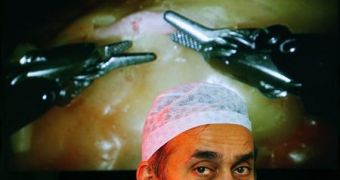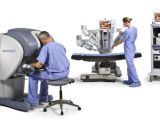Patients who need surgery, especially those suffering from prostate-related illnesses, will be happy to know that technology has made a great step forward towards the incision-free, robot-controlled surgery. New devices will use natural orifices and the vast inner-body network to find the ailing spot and perform precise operations. Until then, robotic surgeons, like the “da Vinci” Surgical System developed by Intuitive Surgical, use a small incision to get to where they're needed.
The Sunnyvale, California-based company is the world leader in robot-assisted minimally invasive surgery, and its “da Vinci” product has been helping surgeons worldwide perform exact operations and saving hundreds of thousands of lives for 10 years. The 3-4 arms of the device are put into motion by joysticks and foot controllers operated by a physician comfortably sitting at the console. The laparoscopic arms are provided with many “EndoWrist” instruments capable of reproducing the movements of a surgeon's hands, only more precise.
The instruments are able to perform all the clamping, suturing and tissue manipulation operations perfectly through the 1-2 cm incision, also ensuring a quick change of the needed surgery tools. Everything is supervised through a hi-res 3D endoscope and image processing device, which enables a real and ample view of the surgical field.
Of course, patients are not very much attracted to the concept of some robot arms lurking inside their bodies, since they're not yet accustomed to the idea. However, using this technology means less trauma on the body (scars, blood loss, infection), less pain, faster recovery time and thus shorter hospitalization periods.
Enhancing this device and making it more popular would also make it a better sell, and decrease its $1.35 million cost in time. Other such robots are undergoing development around the world, or are already performing complex surgery, such as is Canada's “neuroArm,” which removed a brain tumor (a robot first), or Satiety Inc.'s orally ingested stomach stapler for obese patients.
But the level of complexity reached with the “da Vinci” so far differentiates it from its peers. “This is the tip of the iceberg – this is the first car ever invented,” shared Ara Darzi, co-director of the Imperial College's Hamlyn Center for Robotic Surgery in London and a health minister in the UK government, in an interview with Reuters.

 14 DAY TRIAL //
14 DAY TRIAL // 
